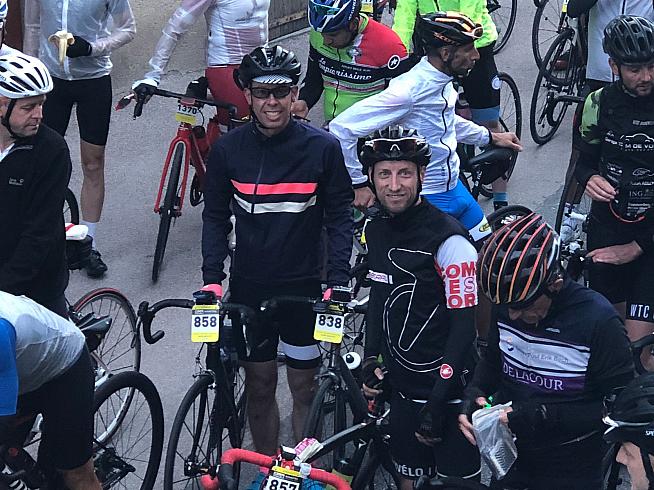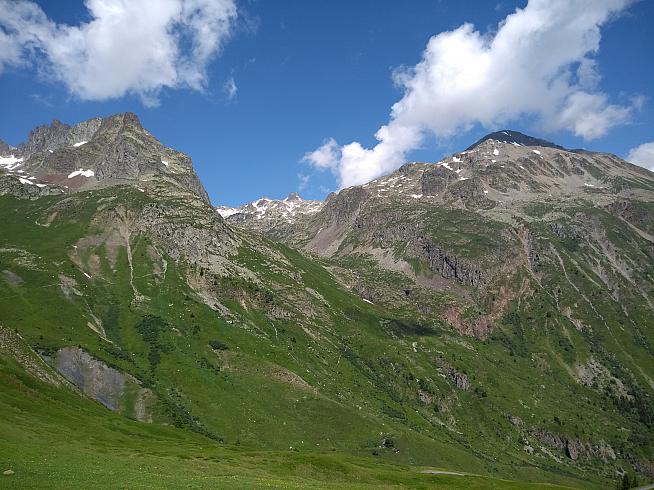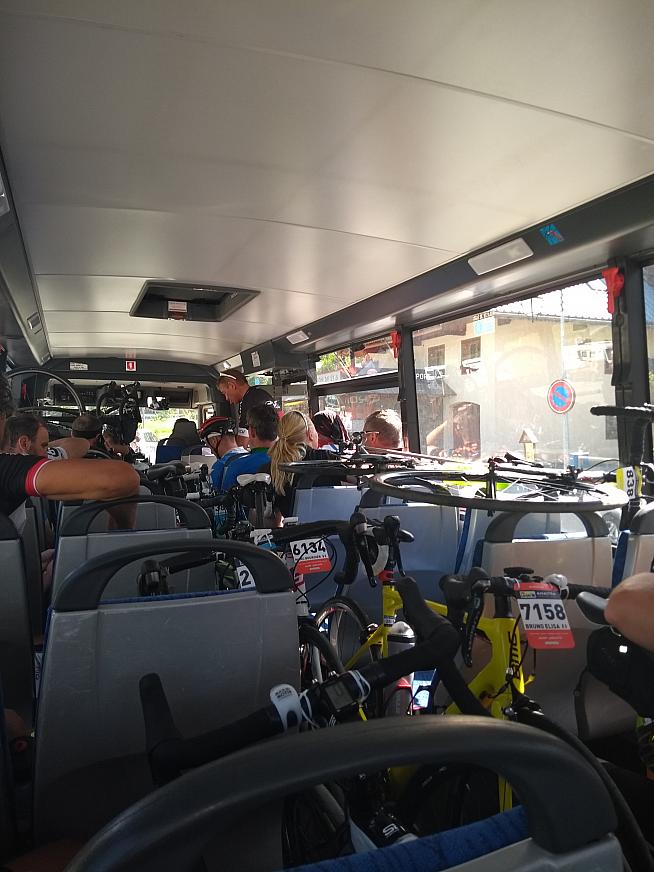If you can't stand the heat, don't ride the Marmotte. That's probably the most important thing I learned this weekend, having abandoned the Marmotte after 100km and suffering the indignity of returning to Alpe d'Huez in the broom wagon.
The day had started well. Allocated the relatively low start number of 858, I was in the front starting pen for the Marmotte by 6.35am on Sunday morning. My friend Dan, who edits GranFondo.com, and his Danish mate Rune were next to me and there was a nervous buzz of expectation and fear among the collection of cyclists gathered from a huge variety of countries. By 7.07 we were crossing the start line and heading along the valley to the base of the Col du Glandon.

Learning my lesson from riding the Marmotte four years earlier, I had resolved to go a bit steadier this time and not burn too many matches in the first half of the race and be left with nothing up the Galibier and Alpe d'Huez. I tucked in behind Dan, who was sheltering on the wheel of a tall Danish rider, and we rolled along at just over 40kp/h while faster riders sped past at ridiculous speeds.
Near the reservoir I jumped on the back of a slightly faster group which dragged me along to the bottom of the Col du Glandon. The Glandon climb is 24km long at an average of 4.8% but that doesn't really do it justice because there is a downhill section in the middle of it and there are some steep sections at around 8% to 10%. I had remembered it from the previous Marmotte as being a fairly easy climb by comparison with the other three major climbs on the route, but this time I thought it was surprisingly tough. I took it slowly and steadily, hitting the top after two hours and 15 minutes, ten minutes slower than in 2014.
With the descent off the top of the Glandon not timed for the purpose of the Marmotte final time (because it is considered a technical and dangerous descent and the organisers don't want people racing down the Glandon), I was happy to stop and refill my bottles (I had drunk one and half bottles up to that point), eat a cheese and garlic pickle sandwich and a Veloforte energy bar. I would have liked to have had a pee but there were just two portable toilets at the feed station, which I don't think is enough given there were 7,500 entrants in the Marmotte.

I descended the Glandon at a reasonable but safe speed, chastened slightly by seeing a man with a bloody face sitting beside the road being treated by medics after what looked like a serious crash. A quick comfort break during the descent left me happier and I got to the village at the bottom of the Glandon (where the timing restarts) and waited for Dan, who was a couple of minutes behind me. We set off together along the valley to Saint Michel de Maurienne, the village where the climb of the Col du Telegraphe starts.
The ride along the valley was fine. We managed to find enough groups to share the work a little, although most were going a little bit too quickly for both of us and we couldn't sustain the pace all the time. It is easy to forget that the valley isn't flat and is in fact a steady climb of 260 metres over the roughly 23km stretch. It isn't ever steep but it is definitely uphill. We stopped briefly at the water station along the way and then headed to the foot of the Telegraphe. By this time it was getting quite hot and I was definitely feeling it.
The Telegraphe was simply not much fun. It is a 12km climb at an average of 7.3% and I thought I would just tap out a slow rhythm up it and get up in my own time. The problem was that I kept overheating and just not feeling good. The temperature in the valley had been in the low 30s and it didn't feel much cooler as we climbed. About 8km up the climb I started getting cramp in my right foot and had to stop to take my shoe off. I stopped a couple of times further up the climb and then I started getting cramp in my left foot too. Four years ago the Telegraphe had been closed to traffic but this year there were plenty of cars coming up and down the climb, which was a great shame (not least because it meant that on half the route you could not ride in the shade, which was on the left side of the road). I reached the top of the Telegraphe (not sure what time as my Garmin failed to record the ride...grrr) and decided not to stop at the feed station there but instead to get to the Valloire feed station and see how I was feeling.
It is mainly downhill to Valloire but the feed station is about 2.5km out of the village and that is all uphill. At this point I was feeling far too hot, very tired and wondering how I was going to be able to climb both the Galibier and Alpe d'Huez.
I reached the feed station after exactly 5 hours riding time and searched for some shade, which I found in the garden of the hotel on the opposite side to the feed station. Dan was at the feed station and asked me how I felt and I explained I was far from great. He suggested I sit down for a while and recover. After about 30 minutes I reached the conclusion I was having a really bad day on the bike (my feet were still cramping) and it would be more sensible to abandon rather than end up in Grenoble hospital or worse (a rider died of heat exhaustion in the 2015 Marmotte). I texted Dan to say that I had given up and he replied that he was going to do the same. He had got about 2km up the road and was feeling sick and weak; he arrived at the hotel about 15 minutes later, looking not very well.
Abandoning the Marmotte is not as easy as I had hoped. I asked a couple of the motorcycle support riders how to do it and they explained that the broom wagon would be along in between an hour and 90 minutes. So we sat with Coca Colas in the garden of the hotel, gradually feeling a bit better but also sad about not completing.
About an hour after deciding to abandon, a Kiwi friend of mine who I know through work turned up and said he was going to stop too. He had four punctures in the first 100km thanks to his carbon wheels overheating and then blowing the inner tubes (admittedly two of the tubes were latex, which is super thin and always likely to not survive an Alpine descent).
A little over two hours after deciding to abandon, Rune texted to say he had finished the Marmotte and it was "one of the hardest things I have ever done". He completed in an official time of 7:49, good enough for a gold medal. Chapeau to him!
At about 4.45 (yes, four hours and ten minutes after I had decided to abandon), the broom wagon turned up. 18 of us were aiming to get on it but the container on the back would only take six bikes. The rest would have to come in the bus with us.
I've written a separate article about the Marmotte broom wagon but all I can say is that the experience of getting back to Alpe d'Huez was dreadful, in an overheated bus with chaotic organisation and a real shortage of any information about what was going on. I do realise that it is poor to abandon the event but it did slightly feel like an additional humiliation that the broom wagon was such a painful affair.

What went wrong? I probably didn't train hard enough but I think I simply just had a bad day. My wife had a virus a couple of weeks earlier which had wiped her out and I had also been under the weather at the time, so I suspect I was probably not fully recovered from that. Could I have struggled on and ridden the Galibier? Possibly, in retrospect I might have been able to. But I think Alpe d'Huez would have finished me off.
Would I ride the Marmotte again? Three days later my answer is "possibly". Having ridden a lot of sportives right across Europe, I do think that the Marmotte is an amazing route and one of the toughest days you can have on a bike. It is a proper challenge for any cyclists and for many people will be the pinnacle of their riding career.
That said, it is a great shame that a decreasing part of the route is on closed roads, which I think detracts from the experience. The feed stations are not that well stocked by comparison with other similar events (such as the Maratona or the Grand Fondo New York series events) and the organisation just feels slightly amateur and in need of some improvement. The route is generally well marshalled and there seems to be good support in terms of medical care, although the mechanical support did seem to leave something to be desired (someone who had blown out their tyre on a descent was not able to buy a spare tyre as none of the support vehicles appeared to be carrying one) and there is a lack of toilets.
You do get a Marmotte branded bag and a couple of very basic lights for your bike (needed for the tunnels between the bottom of Galibier and Bourg d'Oisans) as part of the 90 euros entry fee but by my reckoning the entry fees will be around 650,000 euros and for that sort of money you could do a lot more than is currently offered. In short, a little more love and attention could make this an amazing event rather than just a really good one.
Check out the following Marmotte related articles:
- The Marmotte route profile with detailed analysis of the 174km ride
- Jim Cotton's 2018 Marmotte ride report in which he finished 123rd
- Joe Saumarez Smith's 2014 Marmotte ride report in which he did actually finish
- Dan McCausland's 2014 Marmotte ride report
- Sportive.com Marmotte training and information pages
0 Comments





